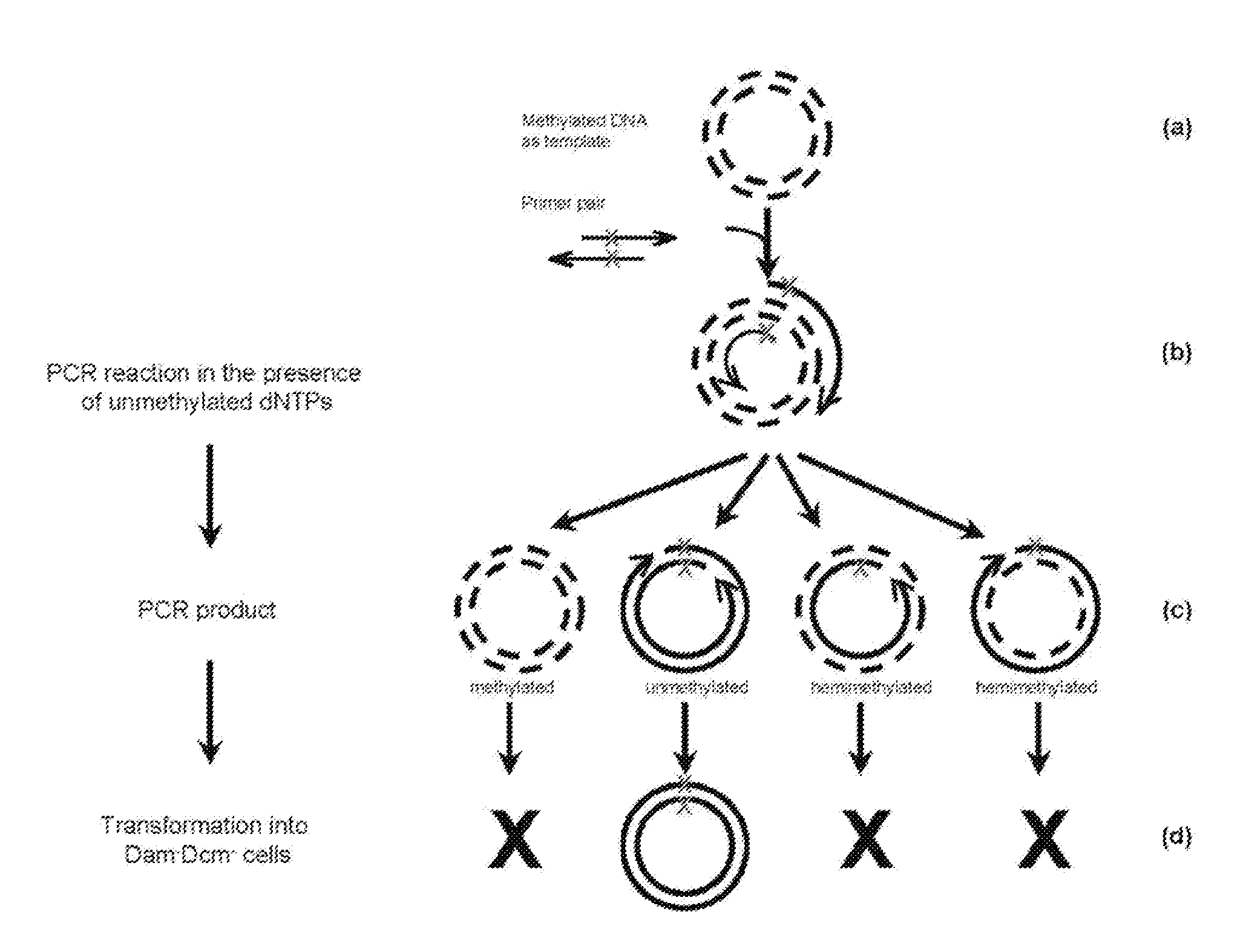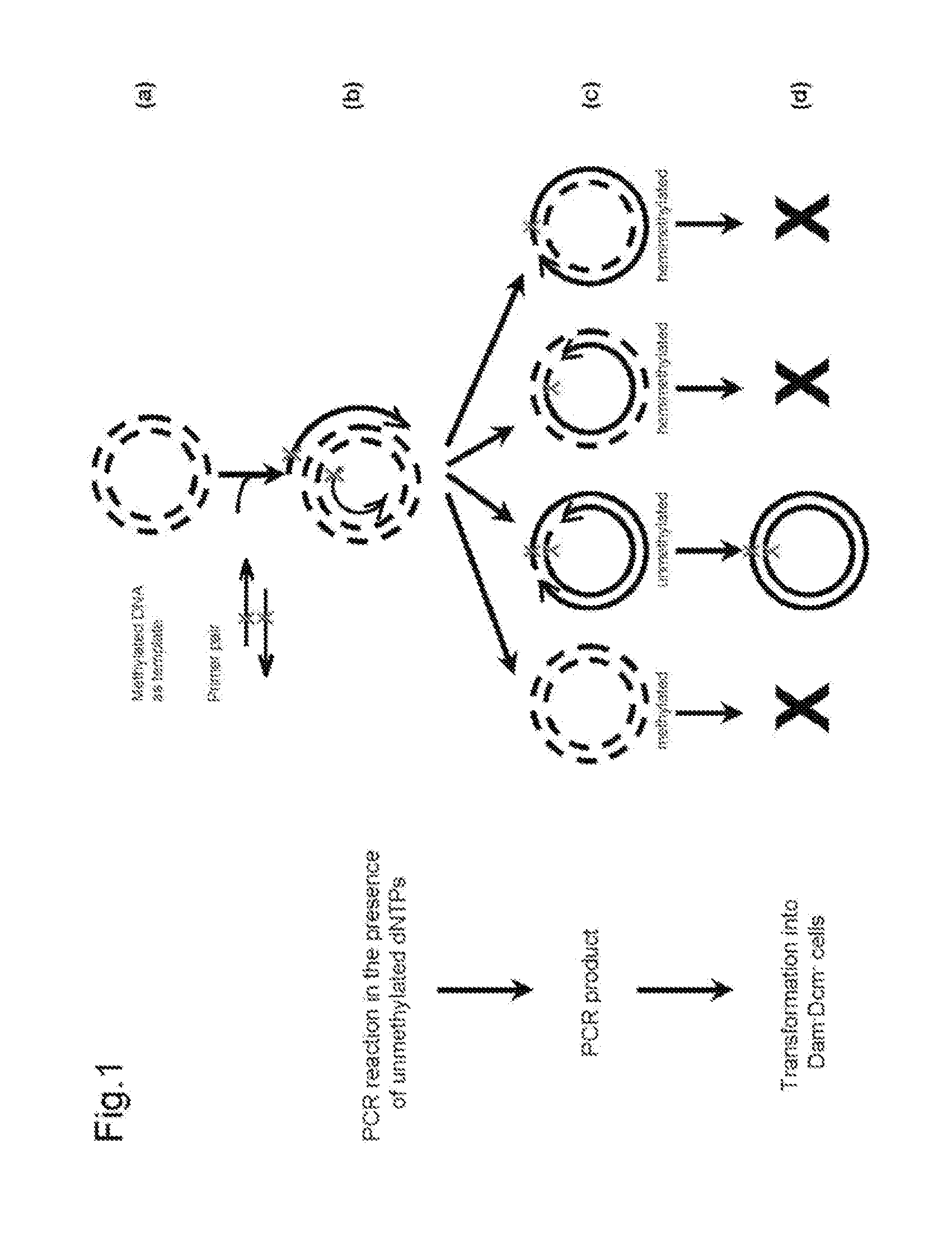Site-directed mutagenesis in circular methylated DNA
a methylated dna and site-directed mutagenesis technology, applied in the field of molecular biology, can solve the problems of needing more time and effort, and achieve the effect of wide compatibility
- Summary
- Abstract
- Description
- Claims
- Application Information
AI Technical Summary
Benefits of technology
Problems solved by technology
Method used
Image
Examples
example 1
[0060]The site-directed mutagenesis of Fip2 by using partially complementary primers wherein mutagenesis sites were in the non-complementary region of one primer comprised the steps of:[0061]1. synthesizing two primers which were partially complementary at 5′ end, wherein the mutations were in the non-complementary region for introducing 3-nucleotides substitution which generates an EcoRV cutting site: (substitutions are denoted in capital letters, and the complementary region between forward and reverse primers is underlined)
Primer #1:cccttgaaaggaaaaattctgGaTAtccatcagag,andPrimer #2:cagaatttttcctttcaagggcctgacacttttc;[0062]2. preparing the reaction solution:[0063]2.5 μl of 10× reaction buffer (BD Biosciences)[0064]10 ng of Fip2 plasmid (GM Biosciences, Inc)[0065]0.5 μl (20 μM) of primer #1[0066]0.5 μl (20 μM) of primer #2[0067]1 μl of 10 mM dNTPs mix (2.5 mM each dNTP) (BD Biosciences)[0068]0.5 unit KOD HiFi DNA polymerase (BD Biosciences)[0069]Double-distilled water to a final vol...
example 2
[0078]The site-directed mutagenesis of Fip2 by using partially complementary primers wherein mutagenesis sites were in the complementary region of both two primers comprised the steps of:[0079]1. synthesizing two primers which were partially complementary at 5′ end, wherein the mutations were in the complementary region for introducing 3-nucleotide substitution which generates an EcoRV cutting site: (substitutions are denoted in capital letters, and the complementary region between forward and reverse primers is underlined)
Primer #3:ggaaaaattctgGaTAtccatcagagttgaatgaaaag;andPrimer #4:ctctgatggaTAtCcagaatttttcctttcaagggc,[0080]2. preparing the reaction solution:[0081]2.5 μl of 10× reaction buffer (BD Biosciences)[0082]10 ng of Fip2 plasmid (GM Biosciences, Inc)[0083]0.5 μl (20 μM) of primer #3[0084]0.5 μl (20 μM) of primer #4[0085]1 μl of 10 mM dNTPs mix (2.5 mM each dNTP) (BD Biosciences)[0086]0.5 unit KOD HiFi DNA polymerase (BD Biosciences)[0087]Double-distilled water to a final v...
example 3
[0091]Fip2 was mutagenized by two completely complementary primers followed the method of the present invention, which comprised the steps of:[0092]1. synthesizing two primers which were completely complementary, wherein the mutation was for introducing 1-nucleotide substitution: (substitutions are denoted in capital letters)
Primer #5:gagctcctgaccgCgaaccaccagctgaaag;andPrimer #6:ctttcagctggtggttcGcggtcaggagctc;[0093]2. preparing the reaction solution:[0094]2.5 μl of 10× reaction buffer (BD Biosciences)[0095]10 ng of Fip2 plasmid (GM Biosciences, Inc).[0096]0.5 μl (20 μM) of primer #5[0097]0.5 μl (20 μM) of primer #6[0098]1 μl of 10 mM dNTPs mix (2.5 mM each dNTP) (BD Biosciences)[0099]0.5 unit KOD HiFi DNA polymerase (BD Biosciences)[0100]Double-distilled water to a final volume of 25 μl;[0101]3. incubating the solution of step 2 in a PCR machine (PTC-200 thermocycler, Bio-Rad,) 95° C. for 5 min to denature the template and 17 cycles at 95° C. 30 sec, 60° C. 15 sec, 72° C. 50 sec;[0...
PUM
| Property | Measurement | Unit |
|---|---|---|
| temperature | aaaaa | aaaaa |
| antibiotic resistance | aaaaa | aaaaa |
| transformation frequency | aaaaa | aaaaa |
Abstract
Description
Claims
Application Information
 Login to View More
Login to View More - R&D
- Intellectual Property
- Life Sciences
- Materials
- Tech Scout
- Unparalleled Data Quality
- Higher Quality Content
- 60% Fewer Hallucinations
Browse by: Latest US Patents, China's latest patents, Technical Efficacy Thesaurus, Application Domain, Technology Topic, Popular Technical Reports.
© 2025 PatSnap. All rights reserved.Legal|Privacy policy|Modern Slavery Act Transparency Statement|Sitemap|About US| Contact US: help@patsnap.com


